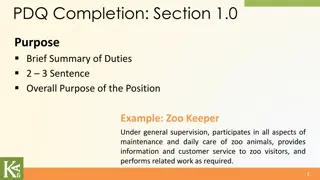Evolution of Video Coding Standards: HEVC in DICOM
Evolution of video coding standards within the DICOM framework, focusing on the integration of HEVC/H.265 for efficient compression of high-quality video data. Explore the transition from MPEG-2 to MPEG-4/AVC, and the adoption of HEVC for enhancing compression efficiency, supporting 4K resolution, and improving content delivery in healthcare imaging applications.
Uploaded on Dec 15, 2024 | 1 Views
Download Presentation

Please find below an Image/Link to download the presentation.
The content on the website is provided AS IS for your information and personal use only. It may not be sold, licensed, or shared on other websites without obtaining consent from the author.If you encounter any issues during the download, it is possible that the publisher has removed the file from their server.
You are allowed to download the files provided on this website for personal or commercial use, subject to the condition that they are used lawfully. All files are the property of their respective owners.
The content on the website is provided AS IS for your information and personal use only. It may not be sold, licensed, or shared on other websites without obtaining consent from the author.
E N D
Presentation Transcript
Overview of HEVC/H.265 Transfer Syntax Supplement 195 DICOM WG4/13 HEVC ad-hoc group June 1st, 2016
Video coding standards history MPEG-2 (1994): Standardized in DICOM in 2004 o Supplement #40 Compression ratio to MPEG-2 4 MPEG-4/AVC (2003): Standardized in DICOM in 2010 o Supplement #149 and #180 2 1 HEVC (2013): Proposed for standardization into DICOM today MPEG-2 AVC HEVC High Efficiency Video Coding Transfer Syntax 2
Domain of application Encode single or multi-frame video content Can be used instead of AVC or MPEG-2 Should be used to compress the size of DICOM video data For compression of video of up to 4k resolution and frame rate of 60fps Main 10 profile usable for HDR and WGC content High Efficiency Video Coding Transfer Syntax 3
Needs for HEVC Smartphones compatibility o HEVC content is already created o As of now, need transcoding to be used in DICOM Higher compression efficiency o For optimized usage of server space and network bandwidth High Efficiency Video Coding Transfer Syntax 4
Differences between AVC and HEVC More efficient o Doubled compression rate More complex o Supported by off the shelf hardware and software Compression artifacts less obvious o Less blockiness High Efficiency Video Coding Transfer Syntax 5
Proposed HEVC profiles HEVC has one profile per type of video Supplement 195 proposes support for 2 profiles: o HEVC Main profile with level 5.1 4:2:0 content Up to 8 bit depth o HEVC Main 10 profile with level 5.1 4:2:0 content Up to 10 bit depth o Both for videos with up to 4k resolution at 60fps High Efficiency Video Coding Transfer Syntax 6
Proposed standardization No new SOP Classes or IODs Addenda to 6 parts of DICOM 2 new transfer syntaxes o HEVC Main profile o HEVC Main 10 profile Essentially similar to AVC transfer syntaxes o Support for audio stream to be encompassed High Efficiency Video Coding Transfer Syntax 7
Availability of HEVC codecs Market is already set up for HEVC 4:2:0 chips New smartphones already support HEVC High Efficiency Video Coding Transfer Syntax 8
Licensing issues (1/2) Fujitsu has no patent pertaining to the inclusion of HEVC inside DICOM HEVC is associated to 2 patent pools known to the Editor of this supplement. No claims to the comprehensiveness of the following list. This is not intended as legal advice: 1) MPEG-LA patent pool: o http://www.mpegla.com/main/programs/HEVC/Documents/HEVCw eb.pdf o Licensing fee only for hardware/software o Not per stream High Efficiency Video Coding Transfer Syntax 9
Licensing issues (2/2) 2) HEVC Advance o http://www.hevcadvance.com/pdf/RoyaltyRatesSummary.pdf o New patent pool // Controversial and criticized o Payment per stream IF stream is sold or rented to a customer High Efficiency Video Coding Transfer Syntax 10
Fragmenting HEVC streams Should we loosen the constraint concerning fragmenting? o Do we enforce the need for a key frame at the beginning of a fragment? This group recommends to loosen the constraint Keep one DICOM object per stream o Limits to 2^31-1 maximum frames (19884 hours at 30fps) High Efficiency Video Coding Transfer Syntax 11
Next Steps Checking the proposed supplement sanity Publishing the supplement for public comment High Efficiency Video Coding Transfer Syntax 12


![❤[READ]❤ Deep Space Craft: An Overview of Interplanetary Flight (Springer Praxis](/thumb/21511/read-deep-space-craft-an-overview-of-interplanetary-flight-springer-praxis.jpg)




















